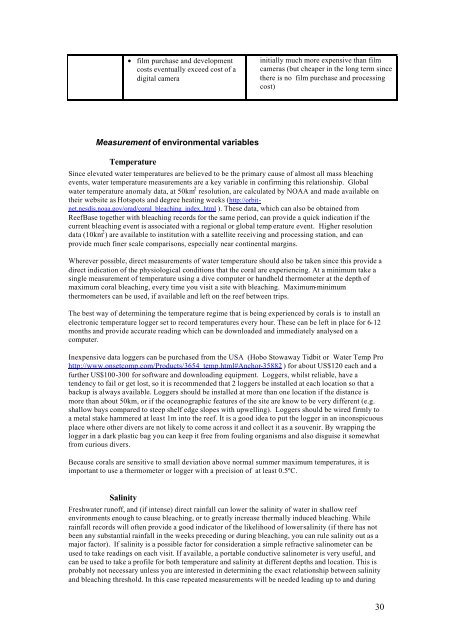Oliver et al (2004) Monitoring bleaching
Oliver et al (2004) Monitoring bleaching.pdf
Oliver et al (2004) Monitoring bleaching.pdf
You also want an ePaper? Increase the reach of your titles
YUMPU automatically turns print PDFs into web optimized ePapers that Google loves.
• film purchase and development<br />
costs eventu<strong>al</strong>ly exceed cost of a<br />
digit<strong>al</strong> camera<br />
initi<strong>al</strong>ly much more expensive than film<br />
cameras (but cheaper in the long term since<br />
there is no film purchase and processing<br />
cost)<br />
Measurement of environment<strong>al</strong> variables<br />
Temperature<br />
Since elevated water temperatures are believed to be the primary cause of <strong>al</strong>most <strong>al</strong>l mass <strong>bleaching</strong><br />
events, water temperature measurements are a key variable in confirming this relationship. Glob<strong>al</strong><br />
water temperature anom<strong>al</strong>y data, at 50km 2 resolution, are c<strong>al</strong>culated by NOAA and made available on<br />
their website as Hotspots and degree heating weeks (http://orbitn<strong>et</strong>.nesdis.noaa.gov/orad/cor<strong>al</strong>_<strong>bleaching</strong>_index..html<br />
). These data, which can <strong>al</strong>so be obtained from<br />
ReefBase tog<strong>et</strong>her with <strong>bleaching</strong> records for the same period, can provide a quick indication if the<br />
current <strong>bleaching</strong> event is associated with a region<strong>al</strong> or glob<strong>al</strong> temp erature event. Higher resolution<br />
data (10km 2 ) are available to institution with a satellite receiving and processing station, and can<br />
provide much finer sc<strong>al</strong>e comparisons, especi<strong>al</strong>ly near continent<strong>al</strong> margins.<br />
Wherever possible, direct measurements of water temperature should <strong>al</strong>so be taken since this provide a<br />
direct indication of the physiologic<strong>al</strong> conditions that the cor<strong>al</strong> are experiencing. At a minimum take a<br />
single measurement of temperature using a dive computer or handheld thermom<strong>et</strong>er at the depth of<br />
maximum cor<strong>al</strong> <strong>bleaching</strong>, every time you visit a site with <strong>bleaching</strong>. Maximum-minimum<br />
thermom<strong>et</strong>ers can be used, if available and left on the reef b<strong>et</strong>ween trips.<br />
The best way of d<strong>et</strong>ermining the temperature regime that is being experienced by cor<strong>al</strong>s is to inst<strong>al</strong>l an<br />
electronic temperature logger s<strong>et</strong> to record temperatures every hour. These can be left in place for 6-12<br />
months and provide accurate reading which can be downloaded and immediately an<strong>al</strong>ysed on a<br />
computer.<br />
Inexpensive data loggers can be purchased from the USA (Hobo Stowaway Tidbit or Water Temp Pro<br />
http://www.ons<strong>et</strong>comp.com/Products/3654_temp.html#Anchor-35882 ) for about US$120 each and a<br />
further US$100-300 for software and downloading equipment. Loggers, whilst reliable, have a<br />
tendency to fail or g<strong>et</strong> lost, so it is recommended that 2 loggers be inst<strong>al</strong>led at each location so that a<br />
backup is <strong>al</strong>ways available. Loggers should be inst<strong>al</strong>led at more than one location if the distance is<br />
more than about 50km, or if the oceanographic features of the site are know to be very different (e.g.<br />
sh<strong>al</strong>low bays compared to steep shelf edge slopes with upwelling). Loggers should be wired firmly to<br />
a m<strong>et</strong><strong>al</strong> stake hammered at least 1m into the reef. It is a good idea to put the logger in an inconspicuous<br />
place where other divers are not likely to come across it and collect it as a souvenir. By wrapping the<br />
logger in a dark plastic bag you can keep it free from fouling organisms and <strong>al</strong>so disguise it somewhat<br />
from curious divers.<br />
Because cor<strong>al</strong>s are sensitive to sm<strong>al</strong>l deviation above norm<strong>al</strong> summer maximum temperatures, it is<br />
important to use a thermom<strong>et</strong>er or logger with a precision of at least 0.5ºC.<br />
S<strong>al</strong>inity<br />
Freshwater runoff, and (if intense) direct rainf<strong>al</strong>l can lower the s<strong>al</strong>inity of water in sh<strong>al</strong>low reef<br />
environments enough to cause <strong>bleaching</strong>, or to greatly increase therm<strong>al</strong>ly induced <strong>bleaching</strong>. While<br />
rainf<strong>al</strong>l records will often provide a good indicator of the likelihood of lower s<strong>al</strong>inity (if there has not<br />
been any substanti<strong>al</strong> rainf<strong>al</strong>l in the weeks preceding or during <strong>bleaching</strong>, you can rule s<strong>al</strong>inity out as a<br />
major factor). If s<strong>al</strong>inity is a possible factor for consideration a simple refractive s<strong>al</strong>inom<strong>et</strong>er can be<br />
used to take readings on each visit. If available, a portable conductive s<strong>al</strong>inom<strong>et</strong>er is very useful, and<br />
can be used to take a profile for both temperature and s<strong>al</strong>inity at different depths and location. This is<br />
probably not necessary unless you are interested in d<strong>et</strong>ermining the exact relationship b<strong>et</strong>ween s<strong>al</strong>inity<br />
and <strong>bleaching</strong> threshold. In this case repeated measurements will be needed leading up to and during<br />
30


















